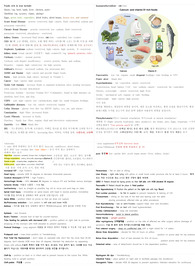

-
 본 문서(hwp)가 작성된 한글 프로그램 버전보다 낮은 한글 프로그램에서 열람할 경우 문서가 올바르게 표시되지 않을 수 있습니다.
이 경우에는 최신패치가 되어 있는 2010 이상 버전이나 한글뷰어에서 확인해 주시기 바랍니다.
본 문서(hwp)가 작성된 한글 프로그램 버전보다 낮은 한글 프로그램에서 열람할 경우 문서가 올바르게 표시되지 않을 수 있습니다.
이 경우에는 최신패치가 되어 있는 2010 이상 버전이나 한글뷰어에서 확인해 주시기 바랍니다.
미리보기
소개
영화자막체!! 로 글씨체 설정해주세요~목차
없음본문내용
Foods rich in iron include:
Meats (eg, beef, lamb, liver, chicken, pork)
Shellfish (eg, oysters, clams, shrimp)
Eggs, green leafy vegetables, dried fruits, dried beans, brown rice, and oatmeal
Acute Renal Disease – protein-restricted, high-calorie, fluid-controlled, sodium and potassium controlled.
Chronic Renal Disease – protein-restricted, low-sodium, fluid-restricted, potassium-restricted, phosphorus- restricted.
kidney Stones – increased fluid intake, calcium- controlled, low-oxalate
CKD K(예: 소금 대체물, 건포도, 브랜, 땅콩 버터), 나트륨(예: 소금), 인(예: 우유)을 피해
인(예: 견과류, 콩)과 칼륨(예: 감자, 콩, 아보카도,바나나, 오렌지) 유제품(예: 우유, 요구르트)
Nephrotic Syndrome sodium-restricted, high-calorie, high-protein, K-restricted.
kidney stone (renal calculi) 신장결석 – high-oxalateXX (eg, spinach, potatoes, tofu),
Cirrhosis (stable) – normal protein
Cirrhosis with hepatic insufficiency – restrict protein, fluids, and sodium.
Hepatitis – regular, high-calorie,low-fat high-protein
Addison’s disease – increased sodium, low potassium diet.
ADHD and Bipolar – high-calorie and provide finger foods.
Burns – high protein, high caloric, increase in Vitamin C.
Cancer – high-calorie, high-protein.
Sickle Cell Anemia – increase fluids to maintain hydration since sickling increases when patients become dehydrated.
Pernicious Anemia – increase Vitamin B12 (Cobalamin), found in high amounts on shellfish, beef liver, and fish.
COPD – soft, high-calorie, low-carbohydrate, high-fat, small frequent feedings
Gallbladder diseases – low-fat, calorie-restricted, regular
Celiac Disease – gluten-free diet (no BROW: barley, rye, oat, and wheat).
Constipation – high-fiber, increased fluids
Cystic Fibrosis – increase in fluids.
Diarrhea – liquid, low-fiber, regular, fluid and electrolyte replacement
Gastritis – low-fiber, bland diet
IBS - 가스생성하는 음식(예: 브로콜리), 카페인, 알코올 및 위장 자극제(예: 고과당 옥수수 시럽, 향신료, 유제품)를 피하기, increasing fiber. 비타민, 미네랄 섭취, 고칼로리, 고단백참고자료
· 없음태그
-
자료후기
-
자주묻는질문의 답변을 확인해 주세요

꼭 알아주세요
-
자료의 정보 및 내용의 진실성에 대하여 해피캠퍼스는 보증하지 않으며, 해당 정보 및 게시물 저작권과 기타 법적 책임은 자료 등록자에게 있습니다.
자료 및 게시물 내용의 불법적 이용, 무단 전재∙배포는 금지되어 있습니다.
저작권침해, 명예훼손 등 분쟁 요소 발견 시 고객센터의 저작권침해 신고센터를 이용해 주시기 바랍니다. -
해피캠퍼스는 구매자와 판매자 모두가 만족하는 서비스가 되도록 노력하고 있으며, 아래의 4가지 자료환불 조건을 꼭 확인해주시기 바랍니다.
파일오류 중복자료 저작권 없음 설명과 실제 내용 불일치 파일의 다운로드가 제대로 되지 않거나 파일형식에 맞는 프로그램으로 정상 작동하지 않는 경우 다른 자료와 70% 이상 내용이 일치하는 경우 (중복임을 확인할 수 있는 근거 필요함) 인터넷의 다른 사이트, 연구기관, 학교, 서적 등의 자료를 도용한 경우 자료의 설명과 실제 자료의 내용이 일치하지 않는 경우
문서 초안을 생성해주는 EasyAI


